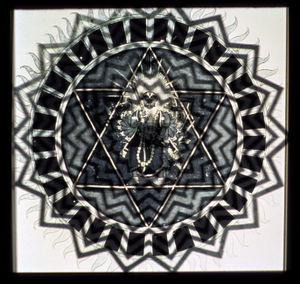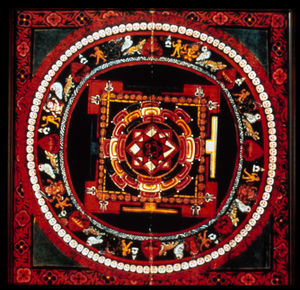Yantra: Difference between revisions
(links) |
m (minor edit) |
||
| (One intermediate revision by the same user not shown) | |||
| Line 1: | Line 1: | ||
''' | [[File:103128M.jpg|thumb|Sri yantra]] | ||
[[File:103135M.jpg|thumb|Wheel of Vishnu]] | |||
[[File:103142M.jpg|thumb|Guhya-Kali Yantra]] | |||
A '''''yantra''''' [Sanskrit] is a geometrical representation of a sound pattern, a diagram used in meditation upon a deity (primarily in tantric worship). | |||
== Mantra and yantra == | |||
The use of yantras as an adjunct to the giving of [[mantra]]s is very ancient. The mantra yogis realized what science has only recently proven: each yantra has a [[Bija mantra|bija syllable]] which is said to hold the inner geometric pattern that is outpictured in the design of the yantra. These yantra designs have existed for thousands of years. They have preexisted the manifest creation as the part of the very sound of the mantra itself emanating from the Word. | |||
It is said that the actual shape of the Sanskrit syllables is related to the seed mantra they denote. Therefore, these are yantras in a sense because the form outpictures the sound. Most yantras have Sanskrit bija syllables in their center. The sound of the mantra is the same sound that formulates the geometry of the design. | |||
Since the essence of the bija sound is the deity himself and since the yantra pattern is the inner geometry of the bija, then it is true that the yantra is the deity and his being can be contacted through it. The yantra acts as a bridge between different planes—from where coagulated sound is a pattern on a piece of silk to the plane where the same sound pulsates as the heartbeat of a cosmic being. | |||
== The use of yantras == | |||
Yantras are used in a way similar to mantras and their goal is the same. By meditating on the image that is the outpicturing of the inner sound of the deity, we progressively become more attuned to his being. The mind begins to flow along the geometry of the yantra’s shape and the mind substance begins to vibrate in concert with the form. As the resonance is established, the attunement is heightened. | |||
Consciousness is meant to flow into unity with the balanced cosmic forces of the pattern. The more love you pour into it, the more you become it, because your love is invested in the yantra. And therefore, by and by, that which you have adored becomes a part of you and is one with you, and thus there is a synthesis between Creator and creation. | |||
== Specific yantras == | |||
All yantras are surrounded by a four-sided geometrical pattern. This design is to act as an invitation for the mind to enter the inner core of the yantra. | |||
The '''Sri Yantra''' is considered the most sacred yantra of all. It is composed of ascending/descending, interlaced triangles. It represents the interaction of the male and female principles. | |||
The yantra known as the '''Wheel of [[Vishnu]]''' depicts him with sixteen arms inside his fiery disc, corresponding to the sixteen petals of the throat chakra. Sixteen arms show the power of God through the Word, through the yantra, through the secret rays. | |||
The '''Guhya-Kali Yantra''' depicts one of the nine aspects of [[Kali]]. There is a great deal of geometric and pictorial symbology all designed from meditating upon the inner being of Kali. | |||
== For more information == | |||
Lecture by Elizabeth Clare Prophet, “Mantra, Yantra and the Science of Sound,” September 14, 1980. | |||
== See also == | == See also == | ||
| Line 7: | Line 41: | ||
[[Mantra]] | [[Mantra]] | ||
== | == Sources == | ||
{{POWref|27|4|, January 22, 1984}} | {{POWref|27|4|, January 22, 1984}} | ||
Lecture by Elizabeth Clare Prophet, “Mantra, Yantra and the Science of Sound,” September 14, 1980. | |||
Latest revision as of 21:07, 14 December 2018



A yantra [Sanskrit] is a geometrical representation of a sound pattern, a diagram used in meditation upon a deity (primarily in tantric worship).
Mantra and yantra
The use of yantras as an adjunct to the giving of mantras is very ancient. The mantra yogis realized what science has only recently proven: each yantra has a bija syllable which is said to hold the inner geometric pattern that is outpictured in the design of the yantra. These yantra designs have existed for thousands of years. They have preexisted the manifest creation as the part of the very sound of the mantra itself emanating from the Word.
It is said that the actual shape of the Sanskrit syllables is related to the seed mantra they denote. Therefore, these are yantras in a sense because the form outpictures the sound. Most yantras have Sanskrit bija syllables in their center. The sound of the mantra is the same sound that formulates the geometry of the design.
Since the essence of the bija sound is the deity himself and since the yantra pattern is the inner geometry of the bija, then it is true that the yantra is the deity and his being can be contacted through it. The yantra acts as a bridge between different planes—from where coagulated sound is a pattern on a piece of silk to the plane where the same sound pulsates as the heartbeat of a cosmic being.
The use of yantras
Yantras are used in a way similar to mantras and their goal is the same. By meditating on the image that is the outpicturing of the inner sound of the deity, we progressively become more attuned to his being. The mind begins to flow along the geometry of the yantra’s shape and the mind substance begins to vibrate in concert with the form. As the resonance is established, the attunement is heightened.
Consciousness is meant to flow into unity with the balanced cosmic forces of the pattern. The more love you pour into it, the more you become it, because your love is invested in the yantra. And therefore, by and by, that which you have adored becomes a part of you and is one with you, and thus there is a synthesis between Creator and creation.
Specific yantras
All yantras are surrounded by a four-sided geometrical pattern. This design is to act as an invitation for the mind to enter the inner core of the yantra.
The Sri Yantra is considered the most sacred yantra of all. It is composed of ascending/descending, interlaced triangles. It represents the interaction of the male and female principles.
The yantra known as the Wheel of Vishnu depicts him with sixteen arms inside his fiery disc, corresponding to the sixteen petals of the throat chakra. Sixteen arms show the power of God through the Word, through the yantra, through the secret rays.
The Guhya-Kali Yantra depicts one of the nine aspects of Kali. There is a great deal of geometric and pictorial symbology all designed from meditating upon the inner being of Kali.
For more information
Lecture by Elizabeth Clare Prophet, “Mantra, Yantra and the Science of Sound,” September 14, 1980.
See also
Sources
Pearls of Wisdom, vol. 27, no. 4, January 22, 1984.
Lecture by Elizabeth Clare Prophet, “Mantra, Yantra and the Science of Sound,” September 14, 1980.
